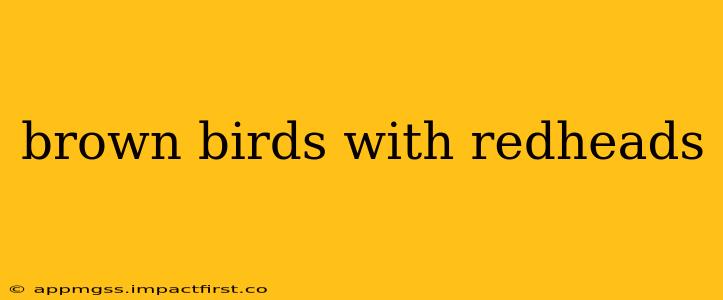Many bird species boast a striking combination of brown plumage and a vibrant red head. This captivating coloration serves various purposes, from camouflage to attracting mates. This guide delves into the fascinating world of these birds, exploring different species, their habitats, and unique characteristics. We'll also address some frequently asked questions about these beautiful avian creatures.
Identifying Brown Birds with Red Heads: Key Features to Look For
Identifying birds accurately requires attention to detail. While a red head and brown body are a good starting point, you need to observe other features to narrow down the possibilities. Key features include:
- Shade of Brown: Is the brown rich and dark, or lighter and more muted? Are there any other colors present, such as streaks, spots, or patches of different hues?
- Shape and Size: The overall body shape (slender, stocky, etc.) and size are crucial indicators. Compare the bird's size to familiar objects like your hand or a nearby tree branch.
- Bill Shape and Size: The beak's shape and size can dramatically influence identification. Is it long and slender, short and stout, or hooked?
- Habitat: Where did you observe the bird? Different species prefer specific habitats – forests, grasslands, wetlands, etc.
- Behavior: Was the bird foraging on the ground, flitting through trees, or soaring in the air? Their behavior can offer vital clues.
What are some examples of brown birds with red heads?
Several bird species fit this description, depending on the geographical location. Some notable examples include:
- Northern Cardinal (Cardinalis cardinalis): This iconic North American bird is instantly recognizable with its bright red plumage (males) and a distinct crest. While the females are more subdued in a brown and reddish-brown coloring, they still possess the reddish-brown tones on their heads.
- Red-headed Woodpecker (Melanerpes erythrocephalus): Found in eastern North America, this woodpecker sports a striking red head and neck, contrasting sharply with its black and white wings and body.
- Red-bellied Woodpecker (Melanerpes carolinus): While the "red-belly" is the more prominent feature, the male displays a red cap and nape, making it a possible candidate for this description.
- Brown-headed Nuthatch (Sitta pusilla): This small bird has a relatively small reddish-brown cap on its head, with a much more dominant blue-gray body coloration.
This is not an exhaustive list; many other birds might exhibit similar coloration depending on the specific subspecies or the angle of observation. Using field guides and online resources with detailed images is vital for precise identification.
What is the significance of the red head in these birds?
The vibrant red coloration on the head serves several crucial roles:
- Sexual Selection: In many species, the bright red head is a key characteristic for attracting mates. Males with more intense red coloration may be seen as more desirable partners.
- Camouflage and Warning Signals: The combination of brown and red can serve as camouflage in certain environments, while the red can also act as a warning signal to potential predators, indicating toxicity or unpleasant taste.
- Species Recognition: The distinct red head helps birds recognize members of their own species.
Where do brown birds with red heads live?
The geographic range varies widely depending on the specific species. Some, like the Northern Cardinal, are widespread across North America, while others, such as certain woodpecker species, have more restricted habitats. It's important to consult regional bird guides for accurate information on the distribution of specific species.
What do brown birds with red heads eat?
The diet of these birds is also species-specific. Some, like woodpeckers, are insectivores, while others consume seeds, fruits, and nuts. Their foraging techniques also differ; woodpeckers are known for their ability to peck into wood, while other species might forage on the ground or in trees.
How can I attract brown birds with red heads to my backyard?
Creating a bird-friendly environment is crucial. This includes providing:
- Food sources: Bird feeders with appropriate seeds, nuts, and fruits.
- Water sources: A birdbath or shallow dish of water.
- Shelter: Trees, shrubs, and nesting boxes can provide safe havens.
By understanding the various species, their habitats, and their needs, you can increase your chances of attracting these captivating brown birds with their striking red heads to your backyard or while birdwatching. Remember to always observe birds from a respectful distance and avoid disturbing their natural behaviors.
